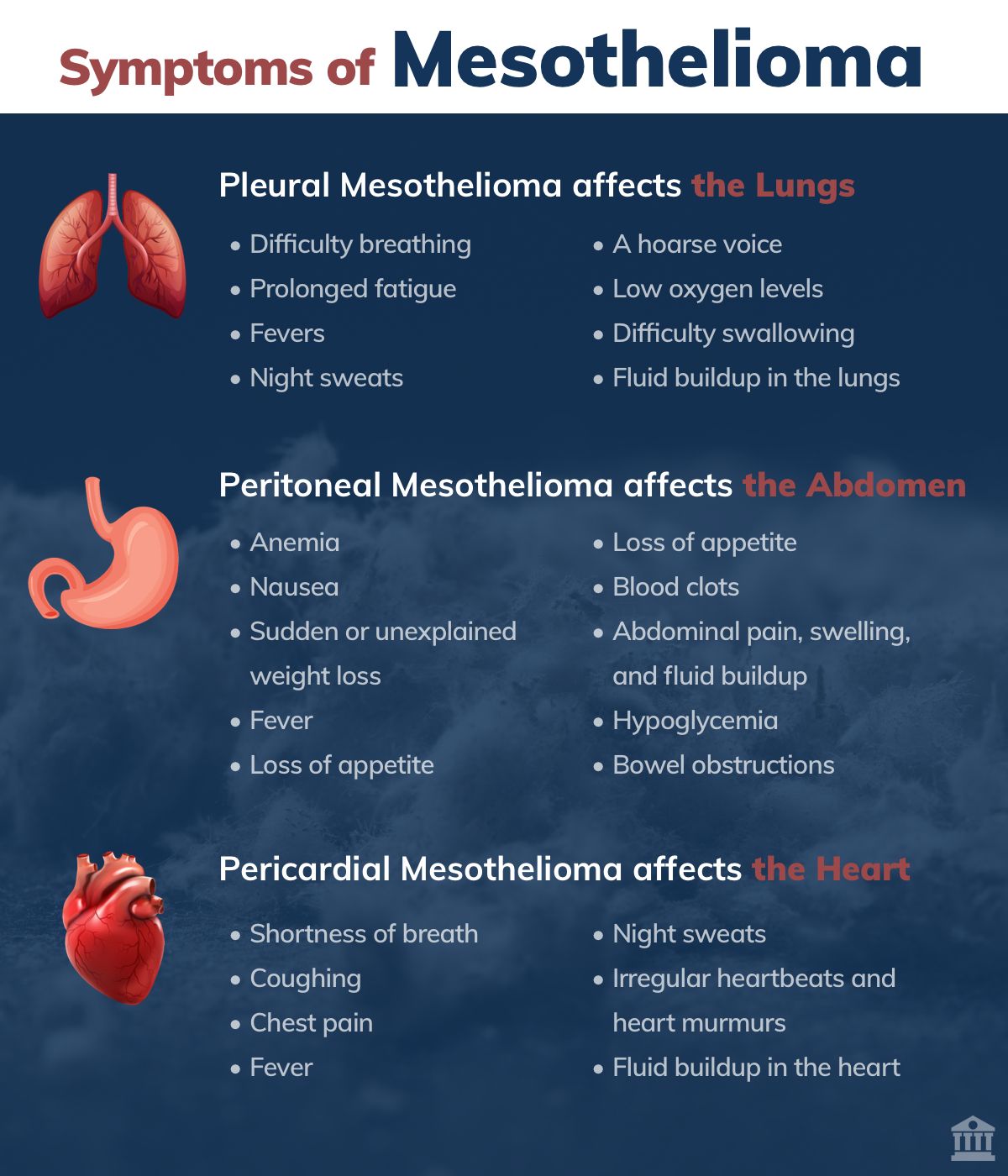Mesothelioma Lawyers Serving Morgantown, WV & Columbus, OH
For many years, asbestos was considered the answer to nearly every manufacturing need. It was used in a wide array of construction materials and building products, and was even used to make fire-retardant clothes.
In 1930 however, it became clear that asbestos was not all it was thought to be. A study published by Dr. E.R.A. Merewether was the first to show that workers were suffering from asbestosis and that the effects of asbestos exposure could lie dormant for years before being noticed. A few years later, in 1943, the first case of mesothelioma was reported.
Despite knowing the dangers of asbestos for years, it wasn’t until 1989 that is was banned by the United States Environmental Protection Agency. Even though asbestos use has now been largely phased out, there are still situations where people can be exposed. These have led to a large number of asbestos exposure lawsuits by individuals seeking compensation for the havoc asbestos has wreaked on their bodies. If you or a loved one have contracted mesothelioma or another asbestos-related disease, contact the asbestos and mesothelioma lawyers at Colombo Law to learn what your legal options are.
What is Asbestos?
The word asbestos actually refers to a group of six different minerals that are known to be found in rock and soil. These minerals are made of tiny, sturdy fibers that are naturally resistant to heat and a variety of chemicals, which is why asbestos was used in building materials for so long. Unfortunately, the properties that make asbestos an excellent construction material are the same ones that can cause mesothelioma and a variety of other lung diseases.
One of the greatest dangers with asbestos is that it is very hard to detect. Odorless and tasteless, asbestos cannot be observed with the naked eye. This makes it hard to detect when someone is being exposed to asbestos. Even touching or handling a product containing asbestos can cause the fibers to fill the air and enter the lungs of anyone nearby.
Where is Asbestos Commonly Found?
The problem with asbestos really is that it has been used for a long, long time. It is everywhere, and even though asbestos removal is now a common practice, it may still be present in some homes, schools, and workplaces. Not only is asbestos found in buildings, but trace amounts can be found in other settings as well. Some of the most common places or things that can contain asbestos include:
- Vermiculite insulation
- Floor and ceiling tiles
- Roof shingles
- House/building siding
- Asbestos based cements
- Insulation, tape, and sheeting used around boilers, electrical units, furnaces, and fireplaces
- Spray on fireproofing products
- Fire resistant cloth/fabric
- Joint compound used around sheetrock
- Asbestos paper and millboard
- Certain kinds of wall and ceiling paints
- Vehicle clutches and brakes
- Public or private water sources
Risk Factors for Asbestos Exposure
Asbestos has a latency period of a minimum of 5 to 10 years. That means if you have been exposed to asbestos, you may not know if you contracted an asbestos-related disease for at least that length of time and, in many cases, longer. In some cases it can take up to 40 years for asbestos exposure to manifest in the form of symptoms or an illness diagnosis.
The likelihood of developing an asbestos-related disease depends on several factors, including:
- Duration – How long the individual was exposed to asbestos.
- Concentration – How much asbestos the individual was exposed to and what the density of the concentration of the fibers.
- Type of Asbestos – Which variety was involved in the exposure and what the size, shape, and chemical makeup of that variety was.
- Frequency of Exposure – How often the individual was exposed to asbestos over time
- Source – Where the asbestos originated from.
- Individual Risk Factors – Whether or not the individual smoked, had pre-existing lung conditions, or were at risk for genetic mutations.

Asbestos-Related Diseases and Symptoms
As mentioned above, risk factors contribute greatly to whether or not an individual is likely to contract an asbestos-related disease. Symptoms may take years to develop and a diagnosis is usually formed after a medical exam, testing, and an in-depth look at the scenarios in which an individual may have been exposed.
Below are some of the most common diseases that can be developed after exposure to asbestos.
Get Help NowNo Obligation - 100% PrivateMesothelioma
Mesothelioma is a rare form of cancer that can affect the linings of the lungs, abdomen or heart. Over 3,000 new cases of mesothelioma are diagnosed in the United States every year. Currently, there is no cure for the disease but research is ongoing and there are treatments that can help improve the chances of survival or prolong the lifespan of patients with mesothelioma.
The overwhelming majority of mesothelioma diagnoses are seen in individuals who have been exposed to asbestos for prolonged periods of time. This commonly occurs after years of exposure in asbestos ridden workplaces, construction sites, and older homes, schools, and public buildings. Since the body cannot break down asbestos fibers, it has been reported that even one exposure incident can lead to mesothelioma.
There are three main types of mesothelioma:
- Pleural Mesothelioma affects the lungs. It is the most common variety of the disease and is responsible for around 80 percent of all diagnoses. Symptoms of pleural mesothelioma may include:
- Difficulty breathing
- Prolonged fatigue
- Fevers
- Night sweats
- A hoarse voice
- Low oxygen levels
- Difficulty swallowing
- Fluid buildup in the lungs
- Peritoneal Mesothelioma affects the abdomen. This type of the disease is responsible for between 15 to 20 percent of all diagnoses. Symptoms of peritoneal mesothelioma may include:
- Anemia
- Nausea
- Sudden or unexplained weight loss
- Fever
- Loss of appetite
- Blood clots
- Abdominal pain, swelling, and fluid buildup
- Hypoglycemia
- Bowel obstructions
- Pericardial Mesothelioma affects the heart. This strain of mesothelioma is extremely rare and accounts for only 1-2 percent of cases. Symptoms of pericardial mesothelioma may include:
- Shortness of breath
- Coughing
- Chest pain
- Fever
- Night sweats
- Irregular heartbeats and heart murmurs
- Fluid buildup in the heart
Lung Cancer
Smokers who are also exposed to asbestos run an even greater risk of developing this terrible disease.
If you have been exposed to asbestos and are experiencing any of the following symptoms, you should make an appointment to see your doctor and have tests performed right away:
- Persistent coughing
- Loss of muscle mass
- Shortness of breath or difficulty breathing
- A sudden hoarse or raspy voice
- Persistent cases of respiratory infections, bronchitis, or pneumonia
- Back, chest, shoulder, bone, or joint pain
- Coughing up mucus and/or blood
- Sudden weight loss
- Fatigue or weakness
- Weakened or brittle bones
- Swelling in the neck, face, or lymph nodes
- Loss of appetite
- Blood clots
- Neurological issues like memory loss, equilibrium issues, or a change in mood or demeanor
Asbestosis
Asbestosis is a non-cancerous result of asbestos exposure. Though it may not be as severe as a cancer diagnosis, asbestosis is a progressive and long-term disease that results in lung tissue scarring after inhaling asbestos fibers. It is possible to live with asbestosis for many years without realizing it and, while it is survivable, it can also be fatal.
As asbestosis progresses, it may cause other serious medical conditions, like high blood pressure, heart disease, lung cancer, and mesothelioma, but common early symptoms of asbestosis may include:
- Shortness of breath
- Persistent cough
- Chest tightness and pain
- Loss of appetite
- Swollen fingertips
- Nail deformities
In addition to those diseases mentioned above, asbestos exposure has also been associated with a variety of other cancers. Researchers are still working to determine how much asbestos exposure influences the development of these diseases, but so far there is evidence that there may be some kind of link between asbestos and laryngeal, gastrointestinal, colorectal, breast, prostate, gallbladder, Hodgkin’s lymphoma, non-Hodgkin’s lymphoma, ovarian, leukemia, and kidney cancers.
Asbestos-Related Laws
In the 1970s, many government bodies and safety agencies have begun writing legislature with the goal of cutting down on, and ultimately eliminating, asbestos exposure. The major laws that relate to asbestos are as follows:
- The Toxic Substances Control Act (TSCA) was enacted in 1976. This banned the manufacturing, importing, processing, and distribution of currently-existing products like asbestos flooring felt, asbestos rollboard, spray-on asbestos materials, and certain types of asbestos-containing paper. It also banned using asbestos in new products that had not previously contained the substance.
- Occupational Safety and Health Administration (OSHA) Asbestos Standards cover a wide variety of industries and workplaces. These standards require employers to provide things like respiratory protection devices, exposure training, medical screening, and decontaminated break/lunch areas.
- The Asbestos Hazard Emergency Response Act (AHERA) requires all education agencies, public or private, to inspect their buildings for asbestos, develop an asbestos management plan, and implement actions designed to reduce or prevent asbestos exposure.
- The Asbestos School Hazard Abatement Reauthorization Act (ASHARA) provided a means of funding loans and grants for asbestos removal in schools. It also mandates that the EPA should increase training for agents of the Asbestos Model Accreditation Plan and require them to receive more training regarding asbestos abatement in all buildings.
Avoiding and Combating Asbestos Exposure
Newer homes and buildings generally do not contain any asbestos, but older homes and buildings may. The best way to find out if you’ve been exposed, or avoid exposure altogether, is to have an expert test the home or building’s air for asbestos fibers. This same person should also be able to examine things like insulation, flooring, and ceiling tiles to determine if asbestos is present.
If your home or building is contaminated, do not attempt to remove the asbestos ridden material yourself. You probably do not have the knowledge needed for safe asbestos removal, and attempting to do so yourself can result in serious or deadly exposure. Instead, hire a contractor who specializes in asbestos removal in order to protect your health and the health of those around you.
Who Could Be Liable for Asbestos Exposure
While OSHA regulations are in place to cut down on asbestos exposure in the workplace, that doesn’t mean these standards and laws are always followed by employers. If you developed mesothelioma or another asbestos-related disease after exposure at work, you be may be able to obtain compensation from your employer.
When asbestos exposure occurs in your living space, you may be able to take legal action against your landlord if you rented or leased a property that was contaminated with asbestos. If the landlord didn’t have any knowledge of the contamination, you will likely have no legal recourse. However, if they dodge inspections or knew about the contamination but failed to disclose it, you may be able to take legal action for your exposure.
Manufacturers of products and equipment that contain asbestos may also be liable for your injuries. When a manufacturer makes a product that contains asbestos, an individual injured by exposure to the asbestos in the product may be able to pursue a product liability claim against the product’s manufacturer or others in the supply chain for that product.
Whether or not you are able to sue your employer, your landlord, or a product manufacturer for asbestos exposure depends on many factors. Asbestos can destroy your health, and it’s exposure should not be taken lightly by anyone. The best way to find out if you have a case is by consulting with one of the mesothelioma and asbestos exposure lawyers at Colombo Law.
What to Do If You’ve Been Exposed
If you think you have been exposed to asbestos in your home, leave the potentially contaminated item alone. Avoid touching it and do not let it get wet. Contact an asbestos removal professional to have them assess the situation and remove the contaminated item if possible. See your doctor immediately and let them know that you think you may have been exposed.
If you think you have been exposed to asbestos at work, it is critical you complete all of the following steps in a timely manner:
- Report your diagnosis or exposure to your employer ASAP.
- Go to the doctor right away. Describe your symptoms and the exposure scenario. Remember, depending on the workers’ compensation standards at your job, you may be able to choose your own doctor or one may be provided for you.
- If you have been diagnosed, provide your employer with a Notice of Occupational Disease and Claim for Compensation form, along with a copy of your medical records.
- Contact an attorney who can help you fight for the settlement your deserve.
Why Should I Hire an Asbestos or Mesothelioma Lawyer?
Most asbestos cases are settled out of court. That said, just because you don’t necessarily have to go to court doesn’t mean you’re going to get the settlement you deserve. Companies and employers do not want to have to compensate you for your medical bills and expenses, pain, suffering, mental anguish and other damages your deserve; they will likely do everything in their power to avoid paying you, such as claiming:
- That smoking or drinking caused your health issues
- That another employer should be responsible for your exposure
- That your diagnosis was not correct
- That your family history suggest you had pre-existing health problems that caused your condition
- That your disease was caused by exposure at home, not the workplace
The asbestos and mesothelioma attorneys at Colombo Law know that this experience is painful and emotionally difficult, and we’ll do everything we can to minimize the stress associated with your case. We’ll be with you every step of the way, from your deposition, to settlement, to trial if that’s what it takes.
We offer free consultations and do not charge for our services unless we help you reach a successful settlement or outcome in your case. Contact us at 888-860-1414 to learn more about how you may be able to get compensation for your asbestos-related illness.










